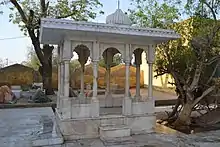Sajjada nashin
The Sajjāda nashīn (Persian: سجاده نشین; lit. "[one who] sits [at a] prayer mat")[1] or Gaddi nashin is a term of Persian origin, used chiefly within the Sufi traditions of South Asia referring to the successor or hereditary administrator of a Sufi master who typically functions as a custodian or trustee at his shrine.[2]

In some cases, the Sajjada Nashin is the descendant of a Sufi or Pir or a descendant of one of their disciples. Sajjada means 'prayer mat' (from the Arabic sajdah or 'prostration') while nashin is the word used for the person seated thereon.[3] A Sajjada particularly tends to the shrine which is made over the Sufi's tomb or grave, known as a Dargah or Mazar. A trustee is a key person who holds and leads the traditional Sufi rituals in the Dargah's daily activities and particularly during death anniversaries called Urs. As a hereditary position the role of Sajjada nashin passes onto a child following the death of the holder.[4]
Pakistani politician Shah Mehmood Qureshi was the Sajjada Nashin of the shrine of Sufi saint Hazrat Baha-ud-din Zakariya Multani but was 'dethroned' following claims he was using his position to further his political career.[5][6]
References
- Schimmel, Annemarie (1980). Islam in the Indian Subcontinent. Leiden: Brill. p. 273.
- "Who is Sajjadanashin?". Sufi Cultural Organization. n.d. Retrieved 9 March 2022.
- Ali, Syed Ameer (1885). The Law Relating to Gifts, Trusts, and Testamentary Dispositions Among the Mahommedans:According to the Hanafi, Maliki, Shâfeï, and Shiah Schools. London: Thacker, Spink and Company. p. 246.
- "Waqar Hussain becomes 12th Sajjada Nashin of Shah Bhitai shrine". Dawn. 31 December 2014. Retrieved 9 March 2022.
- Suhail Warraich (24 December 2017). "Between pirs and politicians". The News on Sunday. Retrieved 9 March 2022.
- "Qureshi 'dethroned' as Sajjada Nashin of Bahauddin Zakariya shrine". The Nation. 29 November 2014. Archived from the original on 9 September 2017. Retrieved 8 September 2017.